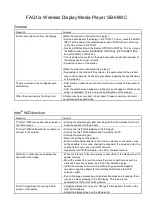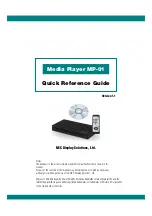
User Guide
(b) For a Class B digital device or peripheral, the instructions furnished
the user shall include the following or similar statement, placed in a
prominent location in the text of the manual: NOTE: This equipment h
as been tested and found to comply with the limits for a Class B digit
al device, pursuant to part 15 of the FCC Rules. These limits are desi
gned to provide reasonable protection against harmful interference in
a residential installation.
This equipment generates, uses and can radiate radio frequency ener
gy and, if not installed and used in accordance with the instructions,
may cause harmful interference to radio communications. However, th
ere is no guarantee that interference will not occur in a particular ins
tallation. If this equipment does cause harmful interference to radio
or television reception, which can be determined by turning the equip
ment off and on, the user is encouraged to try to correct the interfere
nce by one or more of the following measures:
-Reorient or relocate the receiving antenna.
- Increase the separation between the equipment and receiver.
-Connect the equipment into an outlet on a circuit different from that
to which the receiver is connected.
- Consult the dealer or an experienced radio/TV technician for help
Body-Worn operation
This device was tested for typical body-worn operations with the back
of the portable music player kept 5mm. from the body. To maintain c
ompliance requirements, use only belt-clips, holsters or similar acce
ssories that maintain a 5mm separation distance between the user’s
Body and the back of the Portable music player, including the antenn
a. The use of belt-clips, holsters and similar accessories should not c
ontain metallic components in its assembly. The use of accessories t
hat do not satisfy these requirements may not comply with CE RF ex
posure requirements, and should be avoided.
Body-worn accessory exposure conditions “Specific information must
be included in the operating manuals to enable users to select
body-worn accessories that meet the minimum test separation
distance requirements. Users must be fully informed of
the operating requirements and restrictions, to the extent that the ty
pical user can easily understand the information, to acquire the requi
red body-worn accessories to maintain compliance. Instructions on h
ow to place and orient a device in body-worn accessories, in accorda
nce with the test results, should also be included in the user instruct
ions. All supported bodyworn accessory operating configurations mus
t be clearly disclosed to users through conspicuous instructions in the
user guide and user manual to ensure unsupported operations are av
oided. All body-worn accessories containing metallic components mu
st be tested for compliance and clearly identified in the operating man
ual. The instruction must inform users to avoid using other body-wor
n accessories containing metallic components to ensure RF exposure
compliance.”
Miscellaneous
53



































